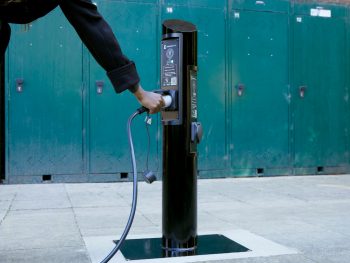Connected Kerb to instal 190,000 on-street chargers by 2030
On-street charging specialist Connected Kerb is to roll out 190,000 EV chargers by 2030 with the help of new funding.

Connected Kerb will install over 4,000 chargers in 2022 alone and the company plans to have 190,000 chargers installed by 2030
The business has secured £110m from Aviva Investors, the global asset management business of Aviva Plc, which will support its plans and enable some 4,000 on-street chargers expected to be installed by the end of this year alone.
As part of the deal, Connected Kerb will also deliver EV charging infrastructure across the insurer’s pan-European real estate portfolio, which includes over 300 major owned assets in the UK alone – one of the country’s largest portfolios.
The deal will help revolutionise access to EV charging for the tens of millions of drivers without off-street parking and will be critical to delivering the Government’s plan of installing more than 300,000 chargers by 2030.
The investment of up to £110m is equivalent to around a quarter of all the money committed by the Government under its flagship Local Electric Vehicle Infrastructure (LEVI) Fund, which launched earlier this year to help local authorities fund on-street EV charging projects.
Chris Pateman-Jones, CEO of Connected Kerb, said: “Our partnership with Aviva Investors will turn EV charging on its head. Successfully delivering the benefits of the EV transition to all – regardless of location, wealth, or circumstance – relies entirely on the UK’s ability to deploy convenient and reliable public charging at scale. For many, it has so far been neither.
“This investment combines the proven long-term reliability of Connected Kerb’s infrastructure with the financial resources and expertise of Aviva Investors to deploy charging, at scale, to all corners of the UK, giving individuals and businesses the confidence to make the switch to electric, and dramatically reduce carbon emissions and air pollution – it’s truly game-changing.”
Aviva said the investment into Connected Kerb would help rebalance the growing gap between EV ownership and public charging infrastructure.
Sean McLachlan, senior director, infrastructure, at Aviva Investors, commented: “The funding we are providing will help to speed up the provision of EV charging to homes and businesses alike, whilst increasing accessibility. We also look forward to working with a management team which has market leading experience in building and operating public infrastructure and integrated smart networks, alongside excellent ESG credentials.”
Connected Kerb, which is based in London, is also planning an expansion into the US, having recently been selected by the New York City Department of Transport and Newlab to deliver an on-street EV charging pilot project in New York that will provide a blueprint for the city to rollout 10,000 on-street chargers by 2030, cutting emissions and improving air quality for millions.













Victor Harman27. Sep, 2022
190,000 of such kerbside chargers, of the 22kW expected minimum power rating, all drawing power together, would consume around 4Gigawatts, or around 5 per cent of the present UK generating capacity. It is also equivalent to around 50 per cent of the UK nuclear power station output. At any one time it cannot charge more than two per cent of the anticipated EV fleet of 10 million EV vehicles by 2030. Couple it then with an equivalent number of, say, 200,000 100kW rapid chargers, all in use simultaneously, and the total draw on the UK generating capacity is then 24Gigawats, near enough 1/3 of the present energy demand. We would need severe management of such charging capacity, or the National Grid will collapse under the load.